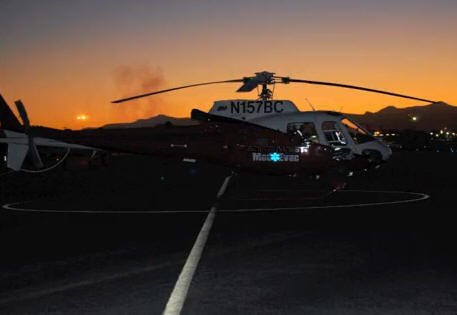
| NEWSROOM |
|
|
 |
|
|
|
|
|
|||
|
By Mike Mitchell |
||||
 |
February 15, 2010
- The NTSB released a preliminary report on the Aerospatiale helicopter
that crashed 23 miles northeast of
The commercial
pilot and two paramedics died in the crash. Night visual meteorological
conditions prevailed and no flight plan was filed for the Title 14 Code
of Federal Regulations Part 135 practice emergency medical services ( |
|||
|
The flight was conducted under an
Several Army personnel utilizing various night vision devices were in
the vicinity of the accident. The Army personnel stated that the
helicopter arrived to the south of the accident site and made two right
turn orbits. The helicopter was seen turning on and panning the white
spot light during these orbits. Personnel on the ground attempted to
make radio contact with the helicopter but were not successful, so they
began utilizing illumination to signal the helicopter.
The helicopter was then observed to make a third orbit which was wider
than the first two. During the third orbit, the helicopter banked
approximately 45 degrees and entered a steep nose down attitude before
impacting the ground. The helicopter collided with relatively level terrain which contained low-lying desert vegetation and the surrounding area was free of towers, transmission wires, and man-made obstacles. The helicopter was found broken into several pieces, the largest of which were found in or near the 18-inch deep impact crater. All major components were accounted for at the accident site. |
||||
|
The post-impact
fire consumed a majority of the cockpit instrumentation. The forward
portion of the right skid toe was found fractured and embedded in hard
soil with signatures consistent with an impact angle of 42 degrees nose
low and 35 degrees of right bank. After initial documentation of the
scene, several components were retained for further examination.
The commercial
pilot had recently been hired by Enchantment Aviation Inc having
previously flown helicopters for the United States Army and Maricopa
County Sheriff's Office. In addition, the pilot held airline transport
pilot certificate with Boeing 737, Boeing 757, Boeing 767, and Lockheed
L-1011 type ratings.
The pilot began
training near the end of November 2009 and on December 22, 2009 the
pilot completed the company's initial pilot-in-command training. On
January 29, 2010, the pilot had completed the company's NVG training
program.
At 1951, an
automated weather reporting station at KELP, located 23 nautical miles
southwest of the accident site reported winds calm, visibility 10 miles,
skies clear, temperature 46 degrees Fahrenheit (F), dew point 28 F, and
a barometric pressure of 30.13 inches of Mercury. |
| ?AvStop
Online Magazine
Contact
Us
Return To News
|
|